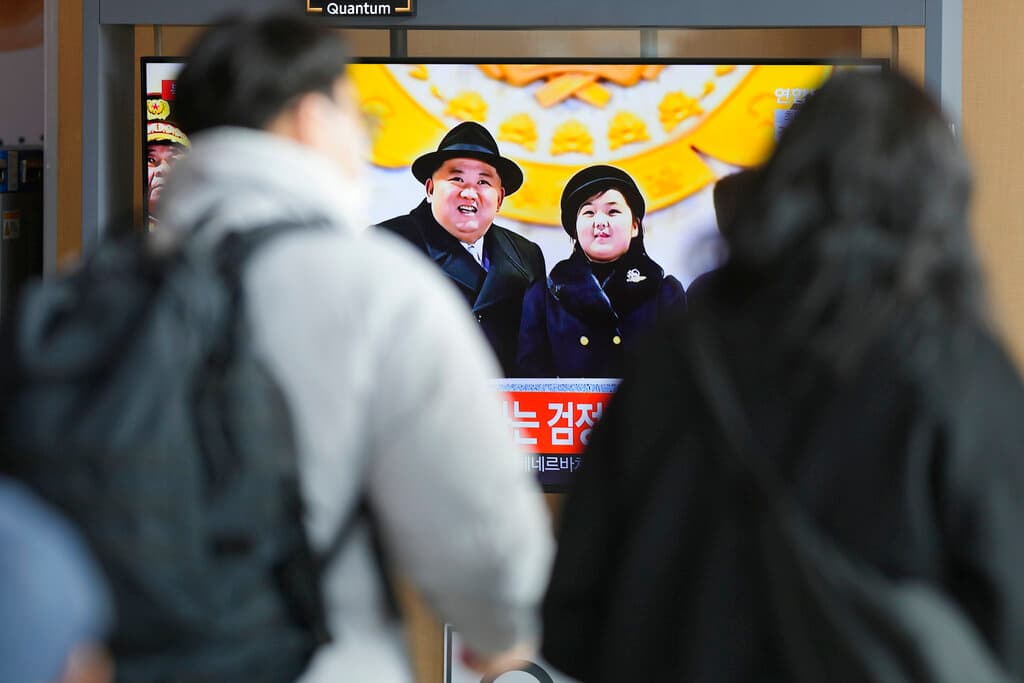Widespread North Korean Famine Under Wraps Amid Dictatorial Displays
Pyongyang’s focus on Kim Jong-un’s 10-year-old daughter is seen as a ploy to make the strongman ‘look like he is just a good old guy, a great, loving, and very human dad.’

All eyes were on a 10-year-old girl gazing at fearsome missiles on parade at Pyongyang to mark the 75th anniversary of the founding of North Korea’s armed forces. Not mentioned was that this week’s parade took place as North Koreans are enduring a time of excruciating hunger that may match the famine of the 1990s that killed up to 2 million people.
After reviewing the extravaganza featuring the North’s latest Hwasong-17 intercontinental ballistic missiles, the country’s dictator, Kim Jong-un, with 10-year-old daughter Ju-ae at his side, heaped praise upon the troops for “defending the eternal prosperity of the country and the wellbeing of the people.” Pyongyang’s Korean Central News Agency said “shouts of ‘Kim Jong Un’ and ‘devoted defense’ rocked the sky as thunder of loyalty.”
The parade, the 13th since Mr. Kim took over after his father’s death in 2011, did nothing to advance the well-being of the vast majority of North Koreans suffering through another winter of discontent and suffering. “Food Insecurity in North Korea Is at Its Worst Since the 1990s Famine,” is the headline of a report from a Washington think tank that tracks North Korea, 38 North.
“Food availability has likely fallen below the bare minimum with regard to human needs,” the report, by Lucas Rengifo-Keller of the Peterson Institute for International Economics, said.
As far as the North Korean media was concerned, however, the story was the missiles that were being trundled by at night along with goose-stepping troops. Hungry people who might not appreciate the misguided emphasis on nukes and the missiles capable of reaching all of the North’s foes, from the United States to Japan and South Korea, would have to watch the whole show on state TV.
Mr. Kim’s daughter, sometimes smiling, sometimes looking serious, often leaning upon his arm, provided a distraction from reality. How better to impress upon his people the glories of weapons guaranteed to insure the North’s superiority over enemies near and far?
The sight of the chubby, healthy-looking royal daughter beside her father may have put a winsome face on a cruel, dictatorial regime while hinting at the future. The health of Mr. Kim, at 39, has long been an issue.
“Kim Ju Ae’s profile is indeed interesting,” Ankit Panda of the Carnegie Endowment for International Peace said. “She was featured alone in a photograph on the fourth page of [the party newspaper] Rodong Sinmun — without her father or mother,” he noted. “It’s uncertain whether or not she is the successor, but she appears to certainly be on the way to a greater public profile and role.”
Yet has Mr. Kim really settled on Ju-ae as the one most likely to maintain the bloodline? “I think this is all about appearances,” an author of numerous books and studies about North Korean leadership, Bruce Bechtol, said. “It will be difficult to make a female the next leader in a Confucian Socialist society.”
Bruce Bennett of the RAND Corporation sees the daughter’s appearance as primarily for domestic image-making.
Mr. Kim “is such a ruthless dictator that I’m sure he has focused attention on his daughter for purposes inside North Korea, to make him look like he is just a good old guy, a great, loving, and very human dad,” he said. “I have to wonder how well that is working, as he makes very senior and experienced military and other leaders pay homage to his young, inexperienced daughter.”
The World Food Program estimates at least 40 percent of the country is undernourished even as the North proudly rejects most forms of foreign aid and still largely closes its borders with China, its only real ally, while battling Covid-19, the pandemic that Mr. Kim claims to have conquered.
“North Korea’s chronic food insecurity is the product of decades of economic mismanagement and internal and external policies,” the 38 North report said.
The report directly blamed “the Kim regime” for having “insisted on maintaining a failed economic model” while “committed to its nuclear program.” Resolving food insecurity would require “strengthening property rights, opening and revitalizing the industrial and service sectors of the economy, and embracing an export-oriented model” — steps the regime has “proved itself unwilling to pursue.”

